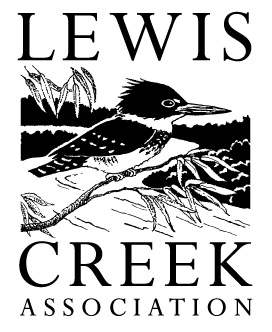Knotweed Removal and Mapping Project
Japanese Knotweed background
Non-native invasive plant species have long threatened the health of ecosystems, wildlife habitat, and populations of native plants in the Lewis Creek watershed. Management can be difficult because they are easily spread via seeds, roots, fragments, animals, and humans.
Japanese knotweed can be a particularly tough plant to remove. It was introduced from East Asia in the late 1800s, and was planted as an ornamental and for erosion control (but ironically, can actually increase streambank erosion). It spreads primarily by its roots/rhizomes, which can break off during a flood then resprout and form a new colony downstream. It is an invader of stream/river corridors, forest edges, roadsides, and drainage ditches. LCA hopes to engage the community to undertake a long-term project controlling knotweed (without herbicides) in our watershed, and we need your help!
Japanese knotweed on the bank of Lewis Creek in Starksboro. Photo by Kate Kelly.
A prior grant from the Lake Champlain Basin/NEIWPCC to LCA documented that knotweed is present in the Lewis Creek watershed, but with a patchy distribution, and has not yet spread prevalently across riverbanks. Knotweed is known to increase soil erosion on riverbanks (Matte et al. 2021), so by reducing its population and limiting spread, this grant will help reduce sediment and phosphorus loading to Lewis Creek and Lake Champlain, while also demonstrating a non-chemical removal method to the public at a demonstration site (in North Ferrisburgh) to help protect the downstream 5.6 river miles from knotweed invasion. Although there are sites upstream with knotweed, this particular site is easily accessible, and includes a variety of infestation types (e.g. a knotweed-infested section of road bank that is actively spreading toward the creek, and a downstream stretch of knotweed on the bank next to the creek). With a variety of management options for knotweed available (e.g. herbicide, smothering, digging, etc.), and public concern over use of herbicides close to the creek, this project allows LCA to demonstrate a non-chemical control method that is available to anyone without an herbicide applicators license. The objective is to inspire community members to tackle knotweed infestations on their own properties or along their local streams.
If you’re interested in learning more or attending our volunteer removal sessions in Ferrisburgh and/or Starksboro in summer 2025, sign up at https://bit.ly/lca-knotweed
Wondering how to identify knotweed? Download this two-page document that describes how to identify knotweed, and shows images of knotweed at various phases of growth.
Identifying and Mapping Distribution of knotweed
Please consider getting involved in a project that uses community scientists to help us understand the distribution of knotweed in the Lewis Creek watershed using iNaturalist. LCA will use this information to choose sites for future work, and to develop a management plan for two additional sites in the watershed. We have developed directions for using iNaturalist on your mobile device to share information with us about the location of knotweed in the Lewis Creek watershed - it is almost as simple as snapping a picture and clicking a few buttons to share it with us! Download the directions for how to use iNaturalist and share your observation with us here. Note that these directions were developed using an iPhone - the directions might be slightly different if you have a different device.
Management using mechanical methods
Managing Japanese knotweed is an undertaking with site-specific demands. Each infestation location is unique in terms of land orientation, solar exposure, competing plant populations, land use, and hydrology; any management plan must be carefully tailored to the sum circumstances, the package of site conditions. This document attempts to offer guidance on how to manually control knotweed without the use of herbicide, and details a management plan for the Ferrisburgh knotweed demonstration site and two other sites in Starksboro. The document will be helpful for anyone interested in beginning mechanical control work on land near them, or those interested in learning more about what we are doing at the Ferrisburgh site. If you’re interested in learning more in person about our methods, try to attend one of our removal sessions - sign up at https://bit.ly/lca-knotweed
Knotweed Demonstration Videos
LCA held a demonstration event and Q&A with consultant Mike Bald (Got Weeds?), LCA staff, and knotweed removal technicians on August 13, 2025. The first video describes the project background and our work and plans for removing Japanese knotweed at both of our knotweed removal demonstration sites. The second video showcases knotweed removal techniques, our knotweed drying stations, and answers community questions.
This product has been funded wholly or in part by the United States Environmental Protection Agency under Assistance Agreement #00A00707 to NEIWPCC. The contents of this document do not necessarily reflect the views and policies of the U.S. Environmental Protection Agency, nor does the U.S. EPA endorse trade names or recommend the use of any products, services or enterprises mentioned in this document.







